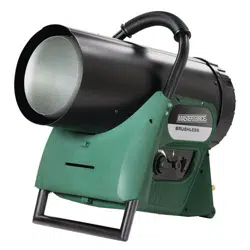Loading ...
Loading ...

Installation of this appliance at altitudes above 2000 ft (610 m) shall be in accordance with lo-
cal codes, or in the absence of local codes, the National Fuel Gas Code, ANSI Z223.1/NFPA
54, or National Standard of Canada, Natural Gas and Propane Installation Code, CSA B149.1
The heater is designed and approved for
use as a construction heater under ANSI
Z83.7 CSA 2.14. It is hard to anticipate ev-
ery use which may be made of this heat-
er. CHECK WITH YOUR LOCAL FIRE
SAFETY AUTHORITY IF YOU HAVE
QUESTIONS ABOUT APPLICATIONS.
PROPANE FORCED AIR CONSTRUCTION HEATERS
This is a direct-red forced air construction
heater for indoor construction use. Its intended
use is primarily the temporary heating of build-
ings or structures under construction, altera-
tion or repair. All the products of combustion
generated by the heater are forced through
the heater and released into the area being
heated. This heater operates at approximately
99%+ combustion efciency but still produces
a small amount of carbon monoxide. Humans
can tolerate small amounts of carbon monox-
ide for short periods. Carbon monoxide can
build up in a heated space and failure to provide
adequate ventilation could result in poisoning
or death.
Other standards govern the use of fuel gases
and heat producing products in specic ap-
plications. Your local authority can advise you
about these.
IMPORTANT: READ THIS USER’S MAN-
UAL CAREFULLY AND COMPLETELY BE-
FORE TRYING TO OPERATE OR SERVICE
THIS HEATER. IMPROPER USE OF THIS
HEATER CAN CAUSE SERIOUS INJURY
OR DEATH FROM FIRE, EXPLOSION
AND CARBON MONOXIDE POISONING.
• Do not use this heater for heating human
living quarters.
• Use of direct-red heaters in the
construction environment can result in
exposure to levels of CO, CO
2
, and NO
2
considered to be hazardous to health and
potentially life threatening.
• Do not use in unventilated areas
• Know the signs of CO and CO
2
poisoning
▫ Headaches, stinging eyes
▫ Dizziness, disorientation
▫ Difculty breathing, feels of being
suffocated
• Proper ventilation air exchange (OSHA
29 CFR 1926.57) to support combustion
and maintain acceptable air quality shall
be provided in accordance with OSHA
29 CFR Part 1926.154, ANSI A10.10
Safety Requirements for Temporary and
Portable Space Heating Devices and
Equipment used in the Construction
Industry or the Natural Gas and
Propane Installation Codes CSA B149.1
AIR QUALITY HAZARD
WARNING: Not for use with
duct work.
▫ Periodically monitor levels of
CO, CO
2
and NO
2
existing at the
construction site – at the minimum at
the start of the shift and after 4 hours.
▫ Provide ventilation air exchange,
either natural or mechanical,
as required to maintain
acceptable indoor air quality
Page 2
Loading ...
Loading ...
Loading ...
